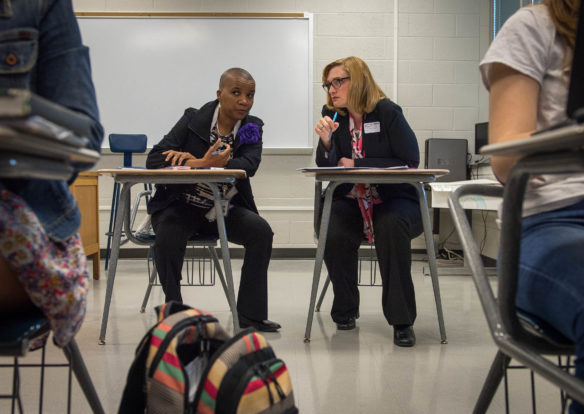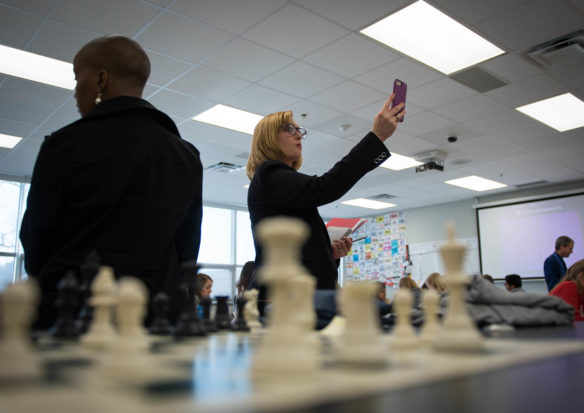
James-Etta Goodloe, left, and Jennifer Pusateri take notes while observing a class at Columbus North High School in Columbus, Ind. The school has been using Universal Design for Learning and Culturally Responsive Teaching concepts for more than a decade. Photo by Bobby Ellis, April 13, 2017
By Brenna R. Kelly
Brenna.kelly@education.ky.gov
Most public buildings used to be built with steps up to the door, then ramps were added – often over the steps – to accommodate people who use wheelchairs.
But today, most public buildings are designed with ramps and steps and even buttons to open the doors.
“Now they are built with an assumption that at some point, there’s going to be someone who uses a wheelchair or a stroller or a walker who is going to need to get into the building,” said Jennifer Pusateri, a consultant in the Kentucky Department of Education’s Learning Services division.
Pusateri and fellow KDE consultant James-Etta Goodloe want to bring that same kind of thinking to Kentucky’s classrooms.
The duo is spreading the word about Universal Design for Learning (UDL) and Culturally Responsive Teaching (CRT) across the state.
“What we have to do is assume that there’s going to be variety in our classrooms,” Pusateri said, “and we have to prepare for that. What CRT and UDL do is say that, you know you are going to have this diversity, so instead of just doing it the way you’ve always done it, maybe you should think about it from multiple perspectives.”
UDL, which was developed by researchers and educators Anne Meyer and David Rose in the 1990s, is a framework to improve teaching and learning for all students based on scientific insights about how people learn. The three tenets of UDL include engaging students, presenting content in several ways and giving students different ways to show what they know.

Jennifer Pusateri, right, and James-Etta Goodloe observe a math class at Columbus North High School to see Universal Design for Learning and Culturally Responsive teaching in action. The two Kentucky Department of Education consultants hope to implement the concepts in Kentucky schools.
Photo by Bobby Ellis, April 13, 2017
“The thought process is that you plan ahead assuming you’re going to have a variety of different learners, different cultural backgrounds, different learning needs in your classroom. If you build supports into the lessons ahead of time, you’re going to be automatically teaching in a way that’s accessible to everyone,” Pusateri said.
Pusateri and Goodloe have been presenting the concepts at state and national conferences and will speak at CAST’s 3rd Annual UDL Symposium this summer. As part of her presentation, Pusateri reads off a list of 15 fruits and vegetables, asking the participants write down as many as they can remember.
Then she holds up pictures of 15 different fruits and vegetables and asks the group to write down as many as they can remember. Some participants remember more from hearing the list, some from seeing the pictures, she said.
The same thing happens in classrooms. Students learn differently, Pusateri said. Many teachers address this by helping the struggling students and giving harder tasks to the students who excel, she said.
“What UDL says to do instead is to build in those accommodations and the acceleration in the planning stage and then they are universally applied to everyone in the classroom,” Pusateri said. “Everybody gets the option of having the accommodations, everybody gets the option of having the acceleration.”
But in order to plan ahead, teachers need to know first what their students need. That’s why teaching in a culturally responsive way is vital part of UDL.
“What we encourage teachers to do is to intentionally take the time to know their students beyond just the first and last name that’s on their roster,” Goodloe said.
CRT means that teachers take into account their own culture and the culture of each student and how it impacts all aspects of learning, she said.
“When you mention culture, there’s a misconception that it’s race and that’s not what it is,” Goodloe said. “Culture is essentially a belief system, it’s a way of doing and being.”
Even if all students in the class look the same, they could each have a different culture, she said. Some students are being raised by single parents, some by their grandparents, and some by same-sex parents. Students could be from rural areas or urban areas, have siblings or be an only child.
“So it’s important for teachers to really intentionally take time to examine and understand the students’ culture, their background, their home life, their experiences,” Goodloe said.
CRT isn’t a step-by-step process that teachers can follow and then say they are culturally responsive, she said. It’s an ongoing process in which teachers must reflect on their own experiences and then take the time to get to know their students and develop relationships with them.
That way, teachers know that when Johnny is sleeping in class, that he was likely up helping with his siblings, or that Susie can’t focus for more than 10 minutes at time without becoming distracted.
“If you don’t go beyond the surface, you’re not getting to the root of why the student is not performing or why they are acting out,” Goodloe said.
With that understanding of what students need, lessons can be planned that cater to both the specific needs of students and that are accessible to all students, Pusateri said.
If the teacher knows Susie can’t focus for more than 10 minutes, then he or she shouldn’t plan a lesson with a 45-minute lecture. By planning a lesson with 10-minute activities, both Susie and Johnny can stay engaged.
“With UDL and CRT, you are planning the lessons with your students’ differences in mind,” Pusateri said.
The same concept can be used for assessment, she said. Not all students are good at taking tests, so teachers can give students options to show what they know. That could include a test, writing a paper or doing a project.
Research has shown that the UDL and CRT practices improve student achievement, reduce behavior problems and increase attendance. Pusateri and Goodloe recently visited Bartholomew Consolidated School Corp., a rural school district schools in Columbus, Ind., which has been using the concepts for more than a decade.
Now Pusateri and Goodloe are hoping to work with schools and districts in Kentucky to implement the ideas into the state’s classrooms.
“This needs to be in every classroom,” Pusateri said. “If this were our tier one instruction in every classroom, it would be amazing how transformative it would be.”
Teachers shouldn’t assume that using UDL and CRT would be just another item to add to their already long list of responsibilities, Goodloe said.
“If you do these things from the very beginning, everything else will fall in place,” she said. “This doesn’t have to be one more thing, this should be the main thing.”
MORE INFO …
Jennifer Pusateri Jennifer.Pusateri@education.ky.gov
James-Etta Goodloe James-Etta.Goodloe@education.ky.gov



[…] Helping all students learn | Kentucky Teacher […]